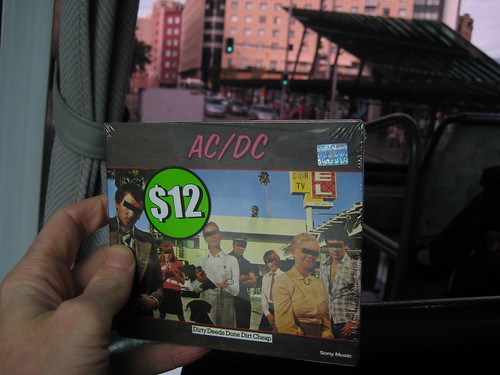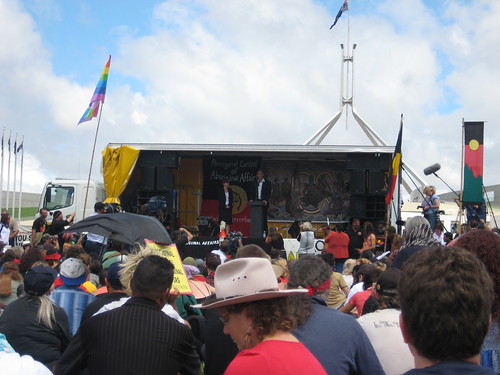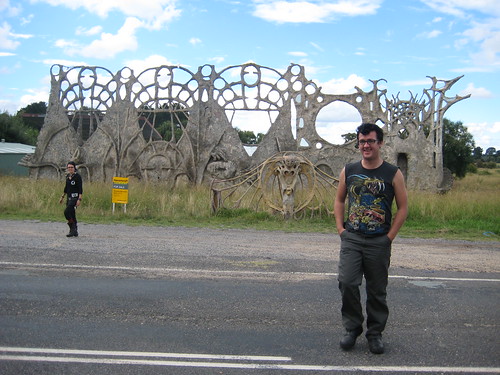
Following Damo’s advice, I went down to Pitt Street looking for “that bargain CD shop near where that vegetarian yum cha place used to be.” Damo had acquired the entire Bon-era back catalogue there at only ten bucks a pop. He said they were imports from Argentina or something. Who knows how the music distribution business works? It’s a mystery to me.
I found the place. It’s called “Dirt Cheap CDs”. Inside, the AC/DC section (which takes up a fair amount of shelf space) was crammed with Brian Johnson-era releases: Flick of the Switch, Fly on the Wall, Stiff Upper Lip etc. etc. (One of these day’s I’ll do an analysis on Acca Dacca album names, there certainly seems to be a pattern there…)
Dirt Cheap CDs only had one Bon-era album: Dirty Deeds Done Dirt Cheap (1976). I figured given the name of the CD, the name of the shop, and the price of the item, it was meant to be. I asked the guy behind the counter if he had any more early AC/DC stuff. “Nah,” he said, “the computer says we’ve got 2 copies of Let There Be Rock, but I went looking for them earlier and I just can’t find them. They keep getting nicked.” Then he added hopefully: “But hey, you should check out some of the post-Bon era albums too, mate. They’re still pretty good!”
I tried to put on the scowl of a die-hard Bon-lover. My look should have communicated: “as IF you’d catch me listening to that shit”, but it was bit on the weak side. Being so new to the AC/DC game, I’m yet to be entirely convinced that the much maligned Brian-era is inferior. My personal listening history is still extremely slim, so I’m sure I present only a thin simulacrum of real fan-like passion. Thus my seething glare ended up communicating: “thanks anyway but this one will do me for the moment! Cheerio, and see you next time…”
There’s nothing like a new CD. In the last few weeks, each time I’ve bought one (and this is only my third, after T.N.T. and Back in Black) I get that rush of anticipation. I pity the old school AC/DC fan, who knows every album back to front, and hangs out, waiting years for any novelty, any re-hashed, re-mastered, digitised, bootleg-fresh-to-light to dribble through to the market. Whereas I, jubilant in my novice-ness, can re-live, each and every week, the exhilaration of a brand new release, as if it were just hot off the press, rushed from recording studio to mixing desk to plastic manufacturing sweatshop to retail outlet.
In this case, I admit I had already heard one song on this album before: Big Balls, an amusing overblown double entendre vanity track Mickie had played for me last week. And of course everyone knows the title track Dirty Deeds Done Dirt Cheap. It has pervasively permeated mainstream culture – you hear it in department stores, KMart, taxicabs, and mechanics workshops, being played over FM radio between the vast and annoying ad breaks. In fact, between the ad breaks isn’t an inappropriate place for it at all. Dirty Deeds is a song masquerading as an advertisement (or vice versa). It’s a jingle for crime-as-small-business, extended to fill the four minute duration of a pop song.
I waited until I climbed aboard the bus to Canberra on Tuesday morning to tear off the plastic and load this one into my old CD walkman. But before I did that, I paused long enough to take a photo of the cover. What I like about Dirty Deeds Done Dirt Cheap, is that it even looks cheap.

The layout is simple: a collage of figures (an old lady, a school boy, a bikie, a nurse(?), a dog, etc) have been cut out of some 1950s magazine and pasted over a photograph of a (French?) motel. Each of these characters (except the dog) looks directly down the barrel of the camera, but each has a black rectangle covering his/her eyes. The meaning of this gesture is unclear: does this array of people represent a cross section of “the community” who will presumably be offended by this album? Or are these the potential customers of the organisation providing said “Dirty Deeds”? Is this, then, why their identities need concealing? Or are they, rather, the victims of those Deeds? Finally, is AC/DC’s act of publishing this music a Dirty Deed in itself?
Indeed, the Dirty Deeds of which Bon sings are on the cheapish side. Sorting out your highschool headmaster, plotting revenge on your best friend for cheating on you behind your back with your girl, or, alternatively, “taking care of” your girlfriend because she nags at you night and day. These are not exactly the dirtiest of deeds I imagine Bon could have got up to in his lifetime, but perhaps these verses were cobbled together pretty quickly (read the lyrics here).
At any rate, as I am discovering with a lot of Bon’s lyrics, they work a lot better when they’re integrated with the whole musical package, rather than when you just read them from a sheet of paper. Verses to contemplate quietly to oneself they aint.
But to return for a moment to the album’s cover art. The cheapness of the album’s graphic design is brought home most strongly NOT by the cut and paste magazine collage, but rather via the text at the top of the album cover. It’s one of those typefaces which is supposed to simulate handwriting – to give a casual feel, like the band name has just been scrawled with a marker pen or something.
I contacted my friend Mickie, who is something of an amateur font fancier, and he suggested this font, called “Komika Title” might have been used. As the name suggests, it’s the kind of typeface you might find in children’s comic books, or for advertising fruit and vegies on A-frame signs by the side of the road. And as such, it’s a far cry from the striking, professional, and somewhat threatening corporate feel of the now ubiquitous AC/DC logo used on many subsequent albums, and emblazoned on just about every piece of band merchandise on the planet. (According to this guy, that logo wasn’t designed until 1977, the year after Dirty Deeds came out).
But enough of this pseudo semiotics-for-beginners. As I unpeeled the plastic shrink wrap from Dirty Deeds, my Murray’s Coach was already hammering down the highway from Sydney to Canberra, where I was attending an indigenous solidarity convergence at Parliament House. The folks that organised the rally were trying to put a whole lot of stuff back on the agenda: Aboriginal deaths in custody, the Palm Island Case, the wrongness of the so-called “Intervention” in the Northern Territory. It’s all full-on stuff, and important to keep in mind, even while the nation celebrates the government’s apology to the Stolen Generations.

If the above paragraph means nothing to you, chances are you’re reading from overseas, or maybe you’ve have had your head in the sand all week. In a nutshell, there’s been a historic acknowledgement of the atrocious record of white Australia in dealing with the original inhabitants of this land.
But then, of course, there’s this: how does any of this stuff overlap with AC/DC anyway? Where is the connection? It’s not as if I’m writing a blog about Midnight Oil, who recorded songs in the 1980s promoting Aboriginal land rights. Was Bon Scott politically conscious in any such way? AC/DC’s songs, as I have discovered, are visceral, playful, and rousing, and create in the listener a kind of joyful aggression. Could this be used for political action? Would Australian AC/DC fans support Kevin Rudd’s apology to the Stolen Generation? Would they support Aboriginal land rights? Are these questions just too weird to be asking?
I’ll venture a few immediate thoughts towards an answer, and then ask a bunch more, before I sign off for today. Clinton Walker, in his book about Bon, wrote that Bon moved, with his band Fraternity, to the Adelaide Hills in 1971. Arguably, Fraternity’s free-love hippy lifestyle was made possible by the politics of Don Dunstan, who was at that time the Premier of South Australia:
Dunstan was a Labor man in a pastel-coloured safari-suit, who set a pace even Gough Whitlam was hard pressed to equal. South Australia was the first to legalise homosexuality, to decriminalise pot, and to recognise women’s rights. When South Australian licencing laws were amended to allow late-night closing, rock’n’roll moved into pubs. The climate was thus perfect for a band that believed it could rewrite all the rules (p. 67).
What’s more, according to the ever trustworthy wikipedia, Don Dunstan later appointed the first ever indigenous governor of South Australia, Sir Douglas Nichols.
Bon was a migrant. He was anti-establishment, connected with the working class. Liked smoking pot. Didn’t like being told what to do, how to behave. And thrived because of progressive politics, in a political climate that was very pro-indigenous. The connections are there just waiting for us, aren’t they? Could Bon have been immune to all of that? Could he really have been oblivious? Was he just an opportunistic party-man, unaware of the political climate which surrounded him, and of his potential role within it? Does a rock song need to specifically reference politics (like Midnight Oil’s Beds Are Burning did) in order to engage with them?
– – –

Speaking of characters who don’t like to be told how to live their lives… on the way back from Canberra, I hitched a ride with Amity, Mickie, Ali, and Dave, and we stopped off at “Hell’s Gate“. When you see the pictures, you’ll realise why it’s so-called. Amity had heard from some friend of a friend that Hell’s Gate is a port-of-call for touring metal bands on the road between Sydney and Canberra. It’s a home-made gothic cathedral facade, which is at once scary and hokey. It looks like something you’d find on the set of Buffy, but less slick. On close inspection, the construction materials reveal themselves as chicken wire, 44 gallon drums, and some sort of souped up papier mache (maybe a concrete-like substance). It’s in the town of Collector, population 150. Rumour has it that the guy who painstakingly constructed the gate was chased out of town by his neighbours, who were obviously freaked out that their small rural-suburban enclave was being invaded by a mad occultist raving lunatic. He took it to court, and won the right to stay and continue on his masterpiece, but not surprisingly, perhaps, he chose to forgo returning to such a hostile environment.
So now the Gate is for sale. The real estate agency number is visible in this photo, if anyone’s interested. I’m sure it’d be dirt cheap.
It’s not so much that the font ‘Komika Title’ was necessarily the font AC/DC used on Dirty Deeds. Y’see when you say i am “an amateur font fancier”, it’s the free fonts you get on sites like Dafont that i like, and it’s because many of em are close copies of expensive and trademarked famous fonts. They are given minor changes by people-pleasing fontographers (ie: bored graphic designers), and are often unstable in Photoshop! Dirty Deeds Done Dirt Cheap!
Nerdy Update:

Mark Evans, who played bass on Dirty Deeds, when I first met him by chance at a pub in Freo, mentioned this version of the Dirty Deeds album. He said he hated it. The whole band didn’t like it, and if they’d had a chance to see it before it got printed and distributed, they would have vetoed it. He doesn’t know who did the design. That design was only used on the international version of the Dirty Deeds album. The Aussie version used this design:
Incidentally, regarding the design of AC/DC’s famous logo, I found the following explanation by the designer, Gerard Huerta, from a blog which thoroughly examines the history and design of band logos:
http://pictograms.blogspot.com/search?q=acdc
Some interesting musings on Dirty Deeds Done Dirt Cheap over here, including the song’s musical resemblances to Zoot, the Supremes, Vanilla Fudge and the Mortein Flyspray ad! Worth a read…
I own the Aussie version of the Dirty Deeds album which I picked up at an imports shop in 1981. The cover art really captures the gritty “up-yours” spirit of early AC/DC perfectly.
I hated the international version cover as well. It looks nothing like AC/DC and I’ve always been baffled by it. I think it’s a case of record co. sanitizing. More than one Aussie album cover was scrapped by the record co. suits for international release, like the version of High Voltage I believe with the dog pissing on the electrical box and the empty beer cans on the ground. What a shame.
DONT QUOTE ME BUT I READ ABOUT A COMPETITION OR SOMTHIN WHERE PEOPLE WERE ASDKED TO SEND STUFF IN… PERHAPS THATS WHERE THIS ALBUM COVER CAME FROM…
If that’s true about an album cover competition, it must’ve been slim pickin’s!
29 years have passed and Bon is still rockin’ hard and strong as ever.
Rock on Bon.
Quote: “a collage of figures (an old lady, a school boy, a bikie, a nurse(?), a dog, etc) have been cut out of some 1950s magazine”
1950s???? Are you for real?? Look at the clothing and hairstyles the figures wear. They are all contemporary for the time the album was released. Men certainly did not wear long hair like that in the 1950s. The figures were clearly NOT from a magazine, nor do they look as if they were. Somebody needs an eye test.
It’s true, I do need to get new glasses, yakofujimato (seriously). But I’m afraid I can’t use that as an excuse for my decade-judgement about that collage.
You could, indeed, be right about it being contemporary imagery rather than then-retro! In my defense, I was only one year old when this album came out, so my direct perception of fashions of the time is limited to nappies.
I own the Aussie version of the Dirty Deeds album which I picked up at an imports shop in 1981. The cover art really captures the gritty “up-yours” spirit of early AC/DC perfectly.
I hated the international version cover as well. It looks nothing like AC/DC and I’ve always been baffled by it. I think it’s a case of record co. sanitizing. More than one Aussie album cover was scrapped by the record co. suits for international release, like the version of High Voltage I believe with the dog pissing on the electrical box and the empty beer cans on the ground. What a shame.
I own the Aussie version of the Dirty Deeds album which I picked up at an imports shop in 1981. The cover art really captures the gritty “up-yours” spirit of early AC/DC perfectly.
I hated the international version cover as well. It looks nothing like AC/DC and I’ve always been baffled by it. I think it’s a case of record co. sanitizing. More than one Aussie album cover was scrapped by the record co. suits for international release, like the version of High Voltage I believe with the dog pissing on the electrical box and the empty beer cans on the ground. What a shame.
The album cover was designed by well-known design firm Hipgnosis. The motel is in the U.S. and called the Rodeaway Inn. It’s at 6842 Sunset Blvd.